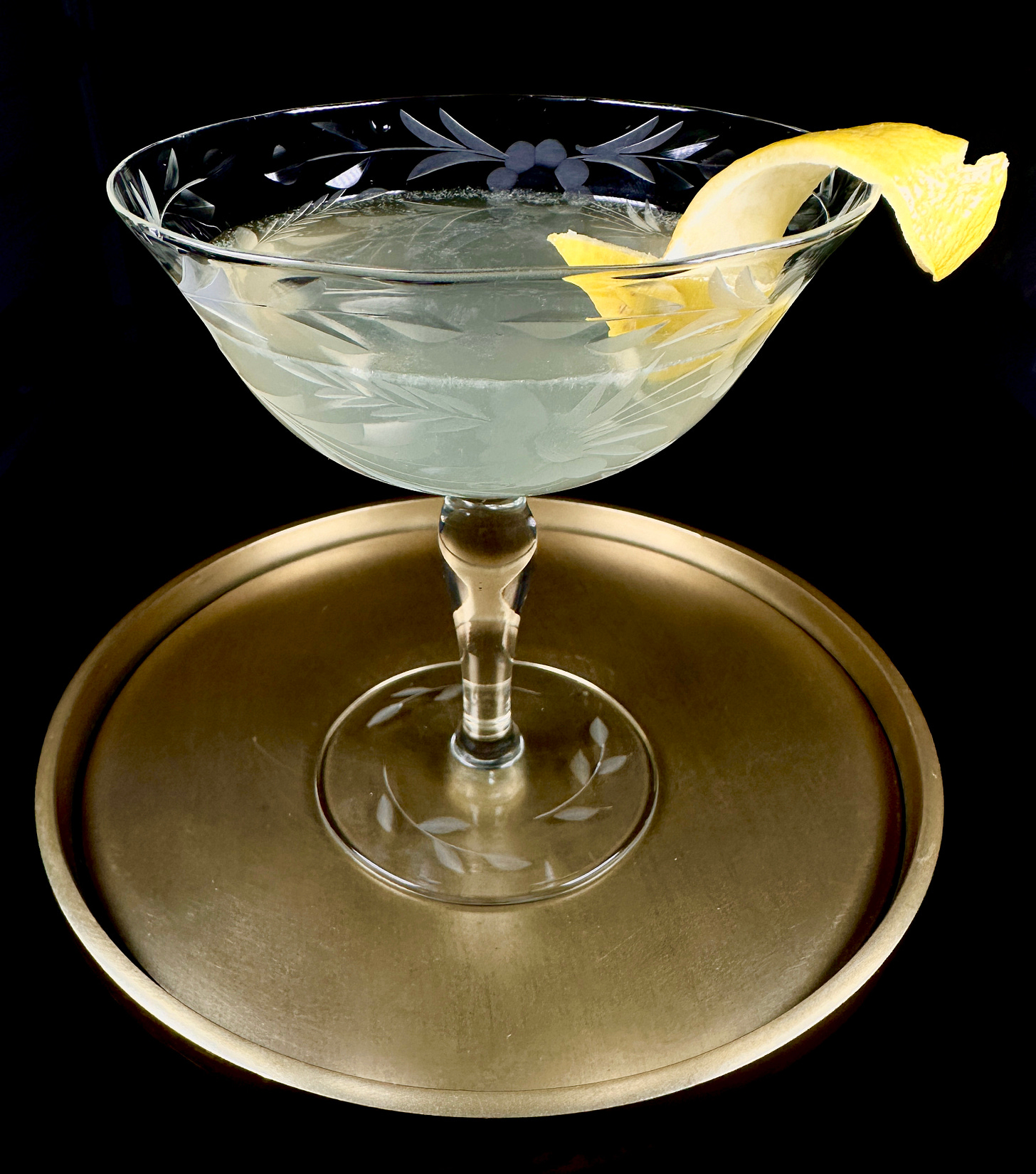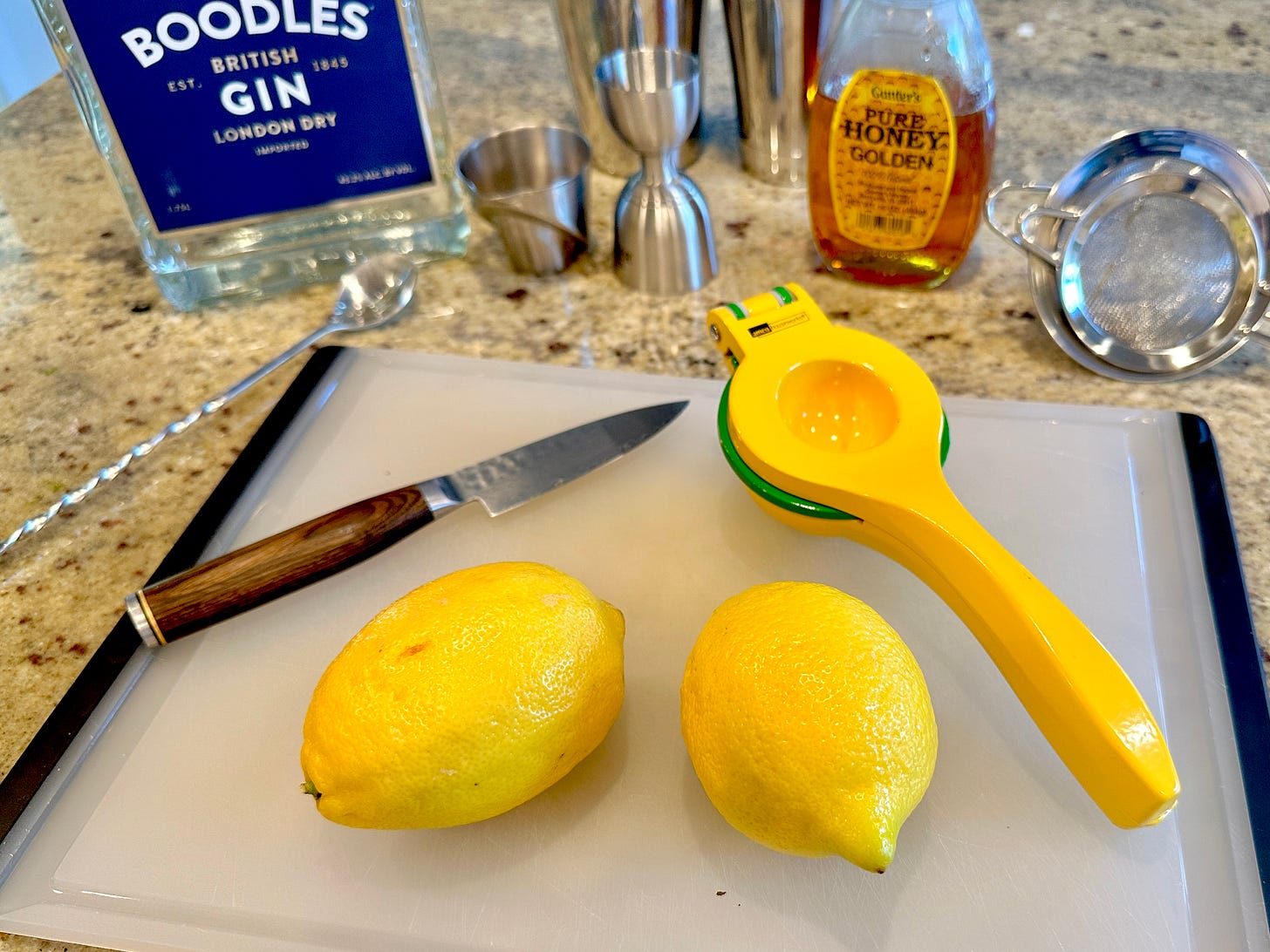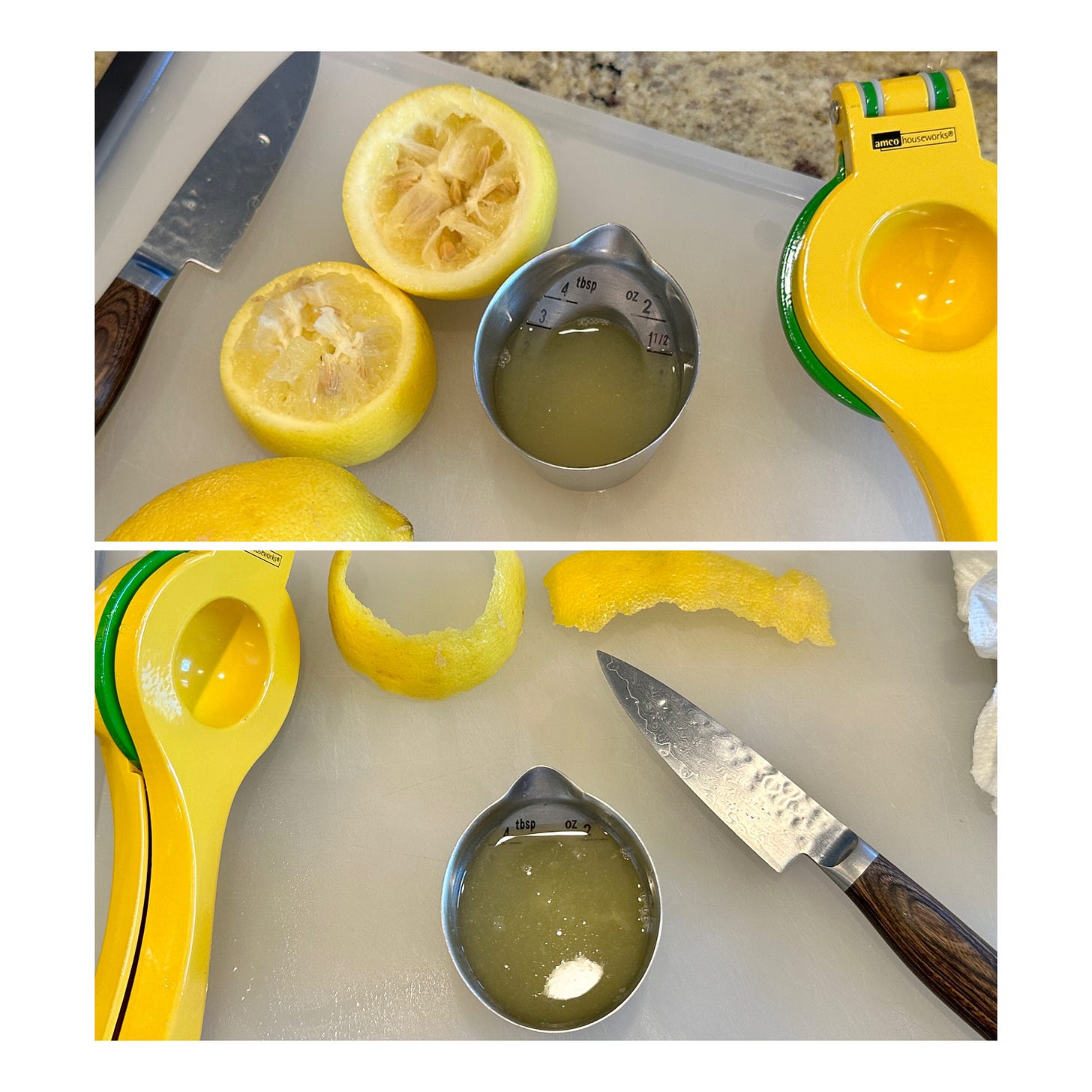The Bee's Knees
Usher in Spring with a Prohibition-era, gin-based cocktail laced with sweet honey syrup.
Difficulty: Easy/Medium
Ingredients: Gin, fresh lemon juice, honey syrup
Gear: Shaker, fruit juicer, mesh strainer, jigger, bar spoon, cocktail glasses, ice
Flavor Profile: Citrus forward, sweet, light but with depth
Countdown to Enjoyment: 10 minutes
Ingredients:
2 ounces gin
3/4 ounce honey syrup (recipe below)
1/2 ounce fresh lemon juice
(Scroll down for recipe and instructions.)
Introducing the Bee’s Knees
We here at The Reluctant Bartender are often fascinated by the history behind the food and drinks we enjoy. Particularly fascinating are those moments when food or drink are the drivers of social, political, or economic change.
Think, the Boston Tea Party. Or, the French Revolution. Or, New Coke.
Or, Prohibition.
That’s right, Prohibition, the grand experiment of cancel culture gone awry. That sad 13 year period when the manufacture, sale, and distribution of alcohol was illegal in the U.S. Ironically, Prohibition and The Roaring Twenties overlapped, which doesn’t seem to make sense at first blush. The mental images associated with Prohibition and The Roaring Twenties don’t align in any way: police dumping hooch in the sewers and taking axes to barrels of wine rub coarsely against images of flappers dancing to jazz in lavish nightclubs.
The Roaring Twenties
As the 1920’s dawned, Americans were ready to par-tay. World War I was over, and the country was in an era of peace and economic prosperity. The decade boomed and there was an explosion of art and culture around the world. It was the Jazz Age, the days of Gatsby and art deco. The world was crazy for movies, telephone, radio, automobiles and aviation.
And alcohol.
Can you even imagine trying to eliminate the sale and distribution of alcohol during this time? Perhaps the government’s brazen attempt to limit access caused an increase in demand that further fueled the fires of the decade? Hard to say.
We’d be remiss if we failed to mention the Flappers, those young women—absolute icons of the Roaring Twenties—who cast off the conservative ideals of the day, and chose to wear short skirts, drink, smoke, and dance The Charleston.
Flapper culture helped to popularize idiomatic expressions such as “the cat’s pajamas” and “the bee’s knees,” two terms that mean the best of the best.
It is during this time in American history that we see the rise of a cocktail known as the Bee’s Knees. We here at TRB have never tasted bathtub gin, but we imagine it was best not to notice the flavor of the spirit. It makes sense that citrus and honey would be brought to bear in an effort to hide the flavor of bootlegger gin, crafted in dank basements by low-level members of organized crime mobs.
Thankfully high quality, craft gin is readily available these days and excellent examples of regional honey are available at everyone’s local supermarket.
Let’s whip up a few rounds and see if the Bee’s Knees really is the cat’s pajamas.
Notes on how to make the Bee’s Knees
Our guiding principle here at The Reluctant Bartender is simplicity. Up until now, our recipes have been fairly simple yet classic concoctions with a handful of ingredients that were stirred together (such as the Manhattan or the Martini).
The Bee’s Knees requires us to create a honey syrup ahead of time, but listen—we’re going to make the process super easy. We know that some our readers are reluctant bartenders specifically because of the complexity often required to fashion drinks like you see at your local cocktail bar, so we will always strive to simplify.
Alas, fret not fearless followers!
While the Bee’s Knees requires a touch of prep, you won’t be tied-up in your kitchen making fancy foams, or emulsions, or any such nonsense. All we need to do is have access to some fresh lemons, and take a few minutes to prepare our honey syrup.
Why Syrup?
This is the first cocktail introduced here at TRB that is sweetened using a syrup. The Old Fashioned was sweetened using a muddled sugar cube. The addition of Vermouth brought sweetness and body to the Manhattan. There are several ways to bring a desired level of sweetness to a drink. Simple syrups are one way to sweeten a cocktail, add body, and in some cases bring additional flavors to the party.
We’re big fans of using homemade syrups for cocktails because most of them are easy to prepare, and bring a lot of flavor and texture to the resulting cocktail. In the case of the honey syrup we’re using here, the syrup brings both sweetness and depth-of-flavor with minimal effort on your part—a tradeoff we’re willing to make for exceptional home cocktails.
A regular simple syrup is just equal parts sugar and water. As we progress along our cocktail journey, we’ll run into syrups that are flavored with fruits like blueberries, or spices like cinnamon, but the core recipe remains a 1:1 ratio of water and sugar. These syrups are normally prepared on the stove, but we are going to take a shortcut here to simplify the assembly process.
Honey syrup is similar to standard simple syrup, but instead of sugar it’s made with a 1:1 ratio of honey and water. Because honey is more easily dissolved in water than granulated sugar, we can shorten the prep time by making use of everyone’s favorite kitchen shortcut: the microwave.
This is all part of our progression. Sure, the Bee’s Knees requires slightly more prep but it’s tiny step that yields a significant jump forward in taste complexity.
A little extra effort for a lot more flavor? Yep, let’s do it.
Making Honey Syrup
Let’s whip up a quick batch of honey syrup. The amount we make here will depend on how many Bee’s Knees you’re planning to mix for your and your guests. It’s easy enough to make more as needed, but here’s a good rough starting guide:
2 cocktails = 1/4 cup of honey + 1/4 cup of warm water
4 cocktails = 1/2 cup of honey + 1/2 cup of warm water
8 cocktails = 1 cup honey + 1 cup of water
We used a mug here in the TRB kitchen to warm the water, but you could just as easily use a glass microwave safe measuring cup. Measure your water, and pop your chosen vessel into the microwave for 20-50 seconds, depending on the amount of water. While the water is warming up, measure out the same amount of honey and when the water is warm, add the room temperature honey to water (don’t put the honey in the microwave).
Use your bar spoon to stir the ingredients together and scrape any lingering honey from your measuring cup. The resulting syrup should flow easily, and have a pleasant taste of sweet honey with a gentle viscosity that will help add depth to our cocktail.
What honey should you use? We used Gunter’s Pure Golden Honey for our Bee’s Knees. We suggest trying different honeys available wherever you live. Farmer’s markets, speciality shops, and even the local supermarket all carry local honey with a variety of different flavors. Experiment! Just try to use a good quality honey, and avoid honey that includes the honeycomb (that is, unless you want to strain out the wax—you don’t want that in your cocktail.)
Squeeze Them Lemons!
Grab a lemon from the fridge. Is it an average sized lemon? Or is it a big honking lemon? Take a look at our pic below. We’d call the lemon on the right an average sized lemon, and the one on the left to be a large one.
An average sized lemon is going to yield right around 1.5 ounces of juice. A large lemon will give 2+ ounces. Yeah, we checked it. Take a peek below:
You can see the smaller lemon (upper picture) yielded almost exactly 1.5 ounces. The big guy on the bottom gave up 2+ ounces and you can’t even read the gradations on the jigger. Since our recipe calls for 1/2 ounce of freshly squeezed lemon juice per Bee’s Knees, you’ll be able to get enough juice from an average lemon to make about three Bee’s Knees. A larger one will get you closer to four cocktails.
We don’t recommend pre-packaged juices for this. Take a minute and squeeze your own fresh fruit. The flavor of the resulting cocktail is worth the extra couple of minutes!
Shake It Baby
This is our first cocktail where the recommended assembly process is to shake the cocktail instead of stirring. Shaking is a much more vigorous process and has a purpose: to integrate fruit juices and syrups when a recipe calls for one or the other. Since our Bee’s Knees has both, we’re gonna shake.
Grab your shaker, and load it up with ice. Measure the ingredients needed for your cocktail, and pop the top on. Shake for 20-30 seconds. Double-strain* into a cocktail glass, garnish with a twist of lemon, sit back and enjoy the bright lemon and gin flavors, with depth and sweetness from the honey syrup.
This is one cocktail that definitely punches above it’s weight.
*Note: “double-strain” means to use both the Hawthorne strainer and a fine mesh strainer. The purpose is to remove small ice chips and any fresh lemon pulp. Mount the Hawthorne on top of your mixer and pour the cocktail through the mesh strainer into your cocktail glass. For more information on basic gear for The Reluctant Bartender, click here to read our recommended list.
Recipe:
Ingredients:
2 ounces gin (we used Boodles in our recipe—substitute with your gin of choice)
1/2 ounce fresh lemon juice
3/4 ounce honey simple syrup
Instructions:
Add ice to your cocktail shaker. Prep your cocktail glasses.
Add gin, freshly squeezed lemon juice, and honey syrup* to cocktail shaker.
Shake for 20-30 seconds until well chilled.
Double-strain into cocktail glasses.
Garnish with a lemon twist.
*To make honey syrup, combine a 1:1 ratio of warm water and honey and stir until the honey is fully dissolved (heat the water only, not the honey). TRB recommends heating the water separately for 20-50 seconds, and stirring the room temperature honey into the warm water.
Wrap Up
The Bee’s Knees is a classic for reason: tart, sweet, with flowery notes from the gin, and an earthy depth from the honey. Feel free to experiment with the ratio of honey syrup and lemon juice. Want a slightly less sweet and more tart version? Swap the amounts around to 3/4 ounce of lemon juice and just 1/2 ounce of honey syrup.
Want a sweeter Bee’s Knees with a more velvety mouth feel? Increase the amount of honey syrup from the base recipe above to a full ounce.
Finally, for those of you who don’t love gin, try this same recipe with your favorite vodka!
Thanks for your continued support for The Reluctant Bartender! Remember to enjoy your newfound cocktail skills responsibly, and have some fun while doing it.






Looking forward to giving it a try. I tend to make 2 or 3 times as much simple syrup as I'll need for the occasion and keep the extra in a small sealed jar in the 'fridge. It stays good for several weeks. I'll probably do the same with the honey syrup.
Gin. My favorite spirit. Nice article. Adding this to our Shabbat dinner.